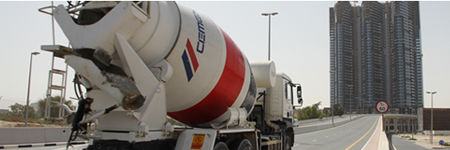Screed
Our Screed Specialty
In UAE variety of screeding options now available, among them we are offering 4 options generally used for screed construction. In an effort to explain those Four different type of screed constructions in a simplified form, we are showing diagrams (Courtesy: CSC Screeding) in sectional format for our valued decision makers. We hope you will find this information helpful in choosing the right specification for your screeding project.

Bonded Screed
This is the type of screed where the Sreeed layer is bonded fully to the substrate using a primer or bonding agent. This type of screed is ideal for thinner section screeds where heavy loading is expected. A bonded screed is generally of15-30mm thick.

Un-Bonded Screed
As the name suggests, un-bonded screeds are not bonded directly to the base, as mechanical scabbing is not possible. Un-Bonded screed is applied to Polythene/ Damp Proof Membrane (DPM) laid on top of the concrete base, which separates it from the main slab. This type is ideal for thickness greater than 50mm for standard screed and 40mm for modified screeds.

Floating Screed
For this type of screed, the screed layer is laid on top of insulation to create thermal insulated flooring.

Foam Concrete
The light weight screed is a foam cellular screeding material when applied over a structure concrete deck, it form a strong continuous, fireproof layer with considerable thermal insulation properties and provide effective slope for proper drainage.
The mixing and casting of the light weight screed is done with an automated machine mainly composed of mixer, aerator, pump, water reservoir, electric panel board and related accessories all set on special trailor.
The finished surface of the light weight screed is smooth, strong and easily repairable in case of any crack development. However, due to its relatively high shrinkage factor, in comparison to normal concrete or screed, the development of hair and minor cracks is an unavoidable phenomenon.
Types of Screeds
One way to achieve the proper elevation and smoothness is to use a screed. The screed's surface is generally smooth and flat, but it can be shaped in any formation to help you achieve the surface you need. Since no concrete pour is the same nor of the same size, different types of concrete screeds are needed. For achieving best results it is best to have the right tool for the right job.

Hand Mixing
This is Suitable only for very small areas and is not Recommended for bigger projects, as the work is strenuous and the estimated Quantities and manual errors while mixing can seriously affect the quality of the Screed.

Ready Mix Screed
Ready Mix Screed is considered to be a good option for work sites where the storage of materials is difficult. But there is always the drawback of heavy traffic posing as a hurdle in getting the screed at the site on time.
For this we have specially designed trolleys that can carry up to 1ton of mortar weight & can fit into lifts & enter into a small passage. It is Advantageous for pouring screed in areas where pumping is difficult or impossible, e.g. Glass closed buildings, working Area, shopping malls etc. Special mechanism allows Unloading in no time
